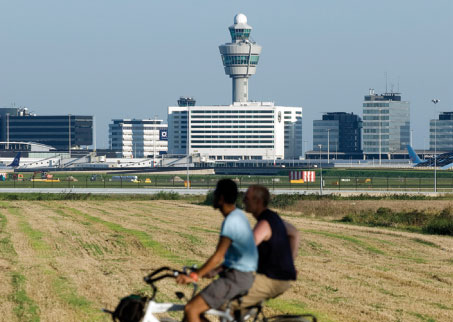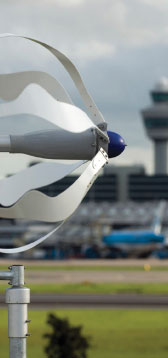
Amsterdam Airport Schiphol recently purchased an electric car, which is being used as transport for staff. Employees at the airport have the chance to test drive the ‘Th!nk City’ car for the next 12 months. More ‘Th!nk City’ vehicles will be ordered if the pilot scheme is a success.
Amsterdam Airport Schiphol is an important driver for the Dutch economy, which has a strong focus on international trade. The aviation industry makes a significant and direct contribution to the economy in terms of employment and makes a substantial contribution to GDP; 1.5% of all earnings in the Netherlands can be attributed to aviation.
The airport saw 47.4 million passengers and more than 428,000 movements in 2008, and recognises its environmental impact on the national and particularly the local community. Therefore, in 2006 a consultation committee was formed and presided over by former Minister of Housing, Spatial Planning and the Environment, Hans Alders. The goal was to advise on the possible balance of aviation growth at Amsterdam Airport Schiphol with reduction of its environmental impact, both in the short-term (to 2010) and in the medium-term (to 2020). “Recently the advice has been presented to the cabinet and is now the guideline for all stakeholders on this theme to base their future developments upon. Within certain boundaries Amsterdam Airport Schiphol is able to grow in movements until 2020, but also has the obligation to develop all kinds of measures that should improve the environmental situation,” said Reinders. “Environmental considerations are very high on the agenda of Amsterdam Airport Schiphol. To contribute to the reduction of the environmental impact, the airport is represented in several working committees in the region at
all levels.”
The airport’s overall environmental policy is to comply and in some cases, pre-empt legislation and regulations. It has set out, in its environmental policy plan, the methods by which it complies with laws and permits and indeed in the areas of CO2 reduction and energy efficiency, Amsterdam Airport Schiphol has targets that extend beyond the current legislation and regulations.

Schiphol Group is developing custom made travel advice for employees; it is also extending the bus network at the airport and implementing a green lease car policy for employees.
The biggest environmental challenge faced at Amsterdam Airport Schiphol, according to Reinders, is growth of air traffic versus impact on the environment. “We continuously have to consider the economic impact versus the environmental impact. Amsterdam Airport Schiphol takes responsibility for its actions and is working hard on reducing its impact on the environment and is determined to reduce this to a minimum. The biggest challenges concern noise, local air quality and water,” said Reinders.
30% CO2 reduction
Amsterdam Airport Schiphol has a clear commitment to carbon efficiency, as evidenced by its participation in the pilot phase of ACI EUROPE’s Airport Carbon Accreditation. The pilot, which took place from October 2008 to January 2009, tested whether the scheme documentation is clear and workable. “It has already given an insight as to what is expected of an airport to become Airport Carbon Accredited,” said Reinders. “We consider carbon efficiency is crucial for Amsterdam Airport Schiphol because it is part of our social and environmental responsibility, it is part of our license to operate and optimising efficiencies can also yield commercial benefits.”
The airport’s Climate Plan defines the scope of all activities and centres on three core areas: Control, Guide and Influence. Control refers to Amsterdam Airport Schiphol’s own activities and here, Reinders explained, the airport has set a goal of achieving carbon neutrality by 2012. “For the activities in Guide and Influence, the goal is to reduce CO2 emissions in 2020 by 30% compared to the level in 1990.”
Two key issues on which Amsterdam Airport Schiphol is actively working to reduce its impact are noise levels and local air quality at and around the airport. “We are well aware of our position within the Dutch and local environment. Therefore, in joint cooperation with Air Traffic Control, airlines and representatives from the local community, we are exploring and implementing such measures,” said Reinders. “Regarding noise, among other things we experiment with operational procedures, develop Continuous Descent Approaches and have designed an innovative barrier for ground noise. At the same time we are also working on local air quality initiatives. An important measure is the implementation of 400 Hz / PCA (Pre-conditioned Air), in the next couple of years we will install facilities at the majority of our gates.”

“Amsterdam Airport Schiphol takes responsibility for its actions and is working hard on reducing its impact on the environment and is determined to reduce this to a minimum. The biggest challenges concern noise, local air quality and water,” said Reinders.
Sustainable energy
The two pillars supporting the Climate Plan are the Sustainable Mobility Perspective and the Energy Blueprint; the aim is to reduce energy and fossil fuel consumption. A programme on mobility measures has been established, as traffic at and around the airport is a large contributor to the local emissions. Measures being developed include differentiated parking tariffs, check-in facilities at railway stations, extension of the bus network at the airport and a green lease car policy for employees.
The Energy Blueprint supports Amsterdam Airport Schiphol’s desire to increase its use of sustainable energy and environmentally friendly fuel. It examines the possibilities with regard to limiting demand for energy and generating sustainable energy at the airport. “The Energy Blueprint is aimed at two objectives: to ensure that our own activities are CO2 neutral by 2012, and to meet at least 20% of our own energy demand by 2020 by means of generating sustainable energy,” said Reinders. “We will be tackling these objectives via our EnergyStrategy 2020 implementation programme, which integrates all efforts and developments in the fields of energy management, energy efficiency, the generation of sustainable energy and awareness-raising.”
Amsterdam Airport Schiphol’s commitment to environmental efficiencies should become more evident to outsiders as its various projects gain ground. With its comprehensive Climate Plan and a key target to achieve carbon neutrality by 2012 – Amsterdam Airport Schiphol is clearly mindful of role that the environment plays in its relationships with airport users, neighbours and the regulators. Its participation in Airport Carbon Accreditation will help it achieve its 2012 target and communicate its actions more effectively.
Environmental initiatives in development
 Several trials with LED lighting and other energy-saving measures
Several trials with LED lighting and other energy-saving measures
- Introduction of the Kerosene Vapour Processor (converts kerosene vapour into useful electricity and heat and improves local air quality)
- Several trials with asphalt and coatings containing Titanium dioxide (TiO2); TiO2 is able to break down pollutants such as NOx
- Pier B has been fitted with battery recharging stations for electric-powered handling equipment
- Pilot with algae basin to speed up the decomposition of fluids used for the de-icing of aircraft
- Construction of a LEED (Leadership in Energy and Environmental Design) platinum certified office building
- Development of a Multi Clean Fuelling Station
- Awareness campaign for energy savings and mobility
- Initiatives for several types of on-site generation of renewable energy







